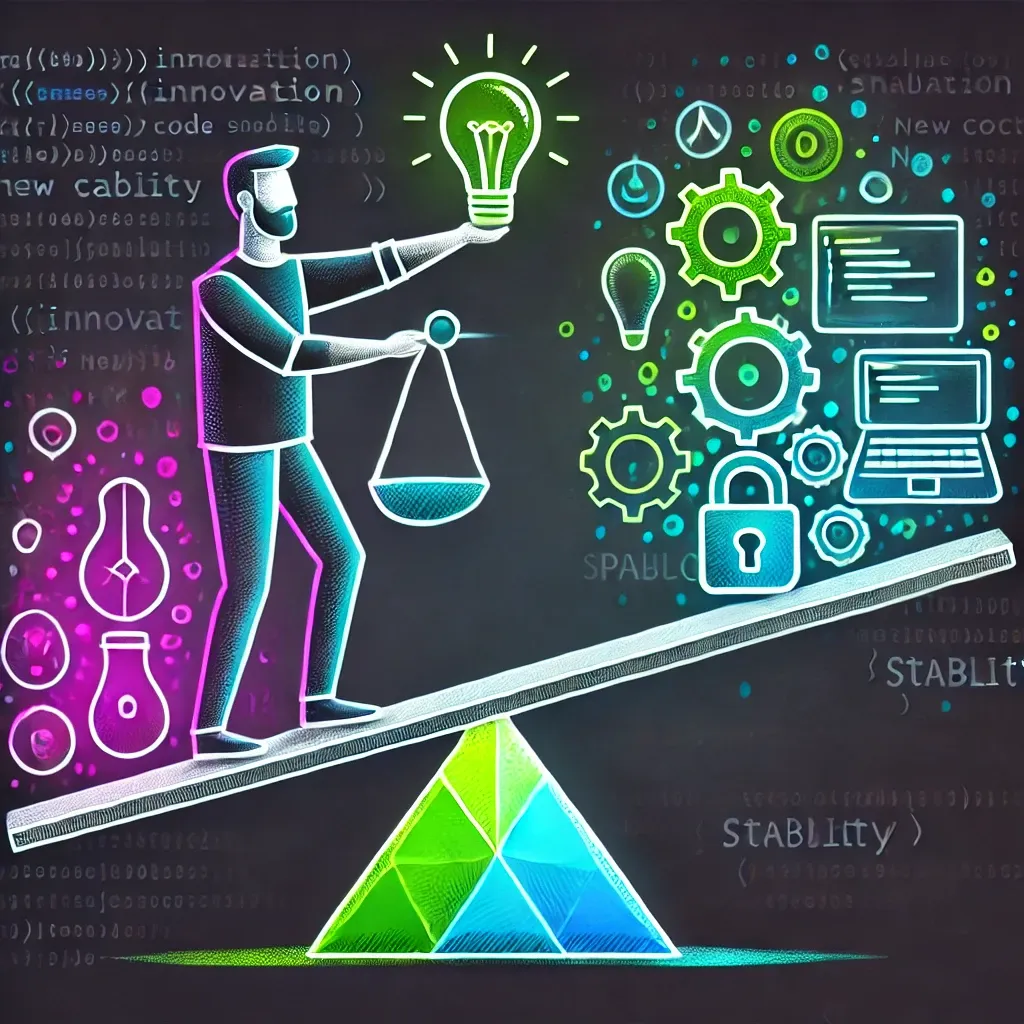Balancing Innovation and Stability in Code: The Art of Not Breaking Everything
Balancing innovation and stability in software to avoid chaos and build dependable products—learn the art now.

Want to know the fastest way to lose your team’s trust? Release code that breaks the whole product. Now, innovation is great—until it causes chaos. So, how do you keep pushing boundaries while making sure things don't fall apart? Balancing innovation and stability in your codebase is an art. It's not about playing it safe; it's about playing it smart. In a world where software is the backbone of everything, mastering this balance is crucial—not just for your team's sanity, but for the success of your product.
🔑 Key Takeaways 🔑
- Innovate Safely: Use sandboxes, feature flags, and A/B testing to introduce new features without risking stability.
- Stability First: Automated testing, code reviews, and documentation are the foundation that keeps your product reliable.
- Iterative Balance: Agile methods, maintenance sprints, and addressing technical debt help maintain the right balance between stability and innovation.
- Adaptation Over Perfection: Accept that balance is never perfect—adapt, iterate, and make calculated risks.
The Innovation Trap
Innovation is exciting. It’s shiny, it’s new, and it’s fun to build. But too much innovation without guardrails is like putting a toddler in the driver’s seat—cute, maybe, but definitely headed for a crash. Before jumping in, ask yourself: Is this worth the potential chaos? The best engineers know that innovation needs purpose, not just novelty.
The key here is to create an environment where you can innovate safely. Think sandboxes, feature flags, and A/B testing. Innovate in controlled ways so you can see what works before flipping the switch across the entire product. Use feature flags to roll out new features gradually, and A/B testing to see what resonates without destabilizing everything. This controlled approach keeps innovation safe and minimizes the risk of breaking your core product.
Stability Isn't Boring—It's Power
Stability sounds boring until everything breaks. Imagine a skyscraper built on shaky foundations—that’s your code if you don't prioritize stability. Stability is what makes your innovation stick; without it, all your great ideas are just expensive experiments.
Here’s what you do: have a solid foundation. Automated testing, code reviews, and documentation aren’t buzzwords—they’re how you make sure your shiny new feature doesn’t send users running to your competitor. Make stability your base layer, and then innovate on top of that. Adopt iterative processes, such as maintenance sprints, to ensure stability tasks aren't ignored. Dedicate time to technical debt, regular code reviews, and use frameworks like MoSCoW to prioritize essential maintenance alongside innovative features.

Finding the Balance
You will never get this balance perfectly right. Accept it now, and you’re already ahead of most engineers. The goal isn’t perfection—it’s adaptation. You need to be okay with making calculated risks. When you decide to push out a new feature, consider the stability debt. If you’re leaning too far into the innovation side, it’s time to pay back that debt—refactor, optimize, test.
Make it a habit to ask yourself and your team: Are we maintaining our stability as we innovate? If not, pause. Sometimes the best way to innovate is to make sure your foundation is rock-solid before adding something new on top. Implement feedback loops and use agile methods to help you adjust quickly—whether it’s an unexpected bug or a change in user needs, agility keeps the balance intact. Remember, addressing technical debt is not just maintenance; it's an investment in your ability to innovate safely down the line.
Conclusion
Balancing innovation and stability isn’t about sacrificing one for the other—it’s about timing. Innovate when your foundation can handle it. Stabilize when you’re getting ahead of yourself. It’s a dance. Master the steps, and you’ll create a product that’s not just cutting-edge, but dependable. Iterative improvements, transparent communication, and user feedback are your allies in this balancing act. Now get out there and build something that doesn’t break everything.
Ready to start innovating without the chaos? Make sure your foundation is rock-solid before stepping on the gas. It’s all about the balance.
FAQ
Q: Why is balancing innovation and stability important in software development?
A: Balancing innovation and stability ensures that while pushing boundaries and adding new features, your product remains reliable and functional, preventing chaos.
Q: What are some effective strategies for maintaining stability while innovating?
A: Use sandboxes, feature flags, A/B testing, and agile methodologies. These tools help you innovate in a controlled way without sacrificing the core stability of your product.
Q: How does technical debt impact innovation and stability?
A: High technical debt can hinder your ability to innovate safely. Addressing technical debt through regular maintenance, refactoring, and technical sprints helps create a stable foundation for future innovations.
Q: What role does agile methodology play in balancing innovation and stability?
A: Agile methods, such as iterative sprints and feedback loops, allow for continuous adaptation, ensuring stability while implementing innovative changes.




